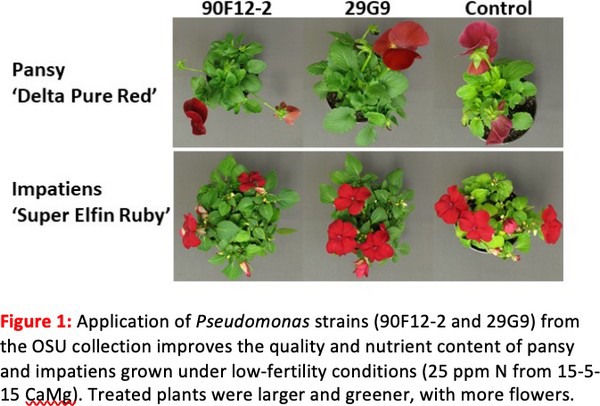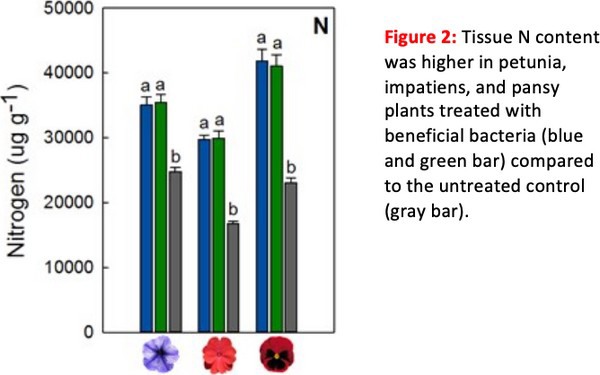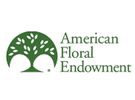The most common active ingredients in biostimulants are beneficial microorganisms (fungi and bacteria). These fungi and bacteria can increase the availability of essential macro and micronutrients that would otherwise be leached from the container. Increasing nutrient uptake and use efficiency improves plant health and tissue nutrient content while reducing the cost of fertilizer inputs.The result is larger plants with greener leaves and more developed root systems, as well as finished plants with more and/or larger flowers.
by Nathan Nordstedt and Dr. Michelle Jones, The Ohio State University
Production timing may be reduced due to faster growth and earlier flowering. Growth promotion from biostimulant applications will be less obvious if plants are already growing under optimal water and fertility levels. Microbial-biostimulants can be used to reduce the amount of fertilizer needed to grow high-quality ornamentals. The efficacy of these products is influenced by the viability of living organisms, so not all biostimulants will work for every growing environment or greenhouse crop, and it is important to make sure you have fresh product that has been stored properly.
Research at OSU identifies bacteria with biostimulant properties.
Research using beneficial bacteria from a collection at The Ohio State University (OSU) identified two strains of Pseudomonas bacteria that increase the health and quality of plants grown under low-nutrient conditions. Petunia, impatiens, and pansy plants were grown throughout the experiment with only 25 ppm N from 15-5-15 CaMg fertilizer to induce low-nutrient stress. Plants were treated weekly with a media drench of diluted bacteria cultures, similar to the application of commercially available biostimulant products, and an untreated control was used for comparison.

The application of beneficial bacteria improved plant quality by increasing plant size and flower number under low-nutrient conditions (Figure 1). In addition, bacteria application improved plant health by increasing the foliar content of nutrients (N, P, K, Ca, Mg, and S) (Figure 2). Microbial inoculants are a common active ingredient in many biostimulant products. Bacteria like these Pseudomonas strains colonize plant roots, forming a beneficial relationship with the plant that improves nutrient use efficiency and enhances plant growth. Successful colonization should reduce the need to reapply microbial inoculants. If plants are fertilized with optimal or superoptimal nutrient levels, growth promotion from these beneficial bacteria may not be seen. Our research shows that the application of beneficial bacteria can provide growers with a solution to decrease fertilizer inputs without sacrificing crop quality, making existing greenhouse practices more economically and environmentally sustainable.

What’s next?
This research has identified bacterial strains that consistently resulted in growth promotion and improved stress tolerance in multiple ornamental species. The goal is for these bacteria to be used in biostimulants that are marketed for the greenhouse industry. The efficacy of biostimulants that contain microbial inoculants is influenced by many different environmental factors, therefore we are continuing to conduct research to determine how different inputs (i.e. fertilizers, PGRs, etc.) and production environments influence the plant responses to bacterial applications. It is also important to continue to optimize application methods and evaluate additional plant species.
For more information
American Floral Endowment
T: +1 (703) 838-5211
www.endowment.org
